Our recent April showers have brought us some beautiful May flowers! We’ve been watching a plant growing on our hillsides since late winter, wondering what it would prove to be. It’s taken a very long time to reveal its true identity, but we now know these plants are Calochortus albus, commonly known as the White Globe Lily, Fairy Lantern, Indian Bells, or Alabaster Tulip.
Until now this plant had been quite an enigma. Every winter long, broad, glossy lanceolate leaves would emerge on some of our steep slopes, almost like giant blades of grass, and then by late spring they’d wither away. Each year nothing else seemed to happen.
However, this year, perhaps because we’ve had a much more normal winter weather pattern, promising long flower stalks were pushed above these mysterious blades.
The grass-like appearance of these plants in winter help to give this genus the name Calochortus, which is derived from the Greek kalos meaning beautiful, and chortus meaning grass.
Calochortus albus is a member of the Liliaceae (Lily) family, and is not only native to California, but its geographic distribution is limited to California. Relative to some of its Mariposa Lily relatives, the Fairy Lantern has a relatively broad range, and is found from the Sierra Nevada foothills, west to Central California, and south to the north Channel Islands, and into San Diego county. Plants are often found on exposed coastal bluffs, chaparral, and partly shaded forested areas and grassland. These plants tolerate serpentine and clay soil, although here they seem to distinctly prefer some of our rockier slopes, regardless as to whether they’re in full sun or part shade.
The pendant flowers, up to a dozen per stem, reportedly emerge between March to July, and this year the first blooms were noticed at the very end of April.
They are only now starting to bloom with any sense of profusion. It’s not clear if blooming year over year is variable here, or if perhaps the deer fence has helped to confer enough protection this year to allow them to bloom.
Not that some haven’t been damaged. These particular specimens are on a steep slope above the orchard, within the deer fence perimeter, and were devoured this last Friday night.
As there was no additional damage suggesting deer, and these particular lilies were close to the road, perhaps our rascally rabbits are responsible?
Additionally, this particular plant seems to have been a target of insect damage of some sort.
When not being devoured, the three flower petals of Calochortus albus are pure white to pink, and sparsely ciliate along the margin, overlapping at the tip to form the characteristic lantern shape of this species.
The sepals may be white, green or rosy red in color.
Some rare bulb nurseries do sell bulbs of this species, but Calochortus albus only grows in USDA zones 9 and 10. In colder climates it is recommended that C. albus is grown in a greenhouse. In its natural setting, Calochortus albus prefers fast draining soils, on steep slopes in full to partial sun. In cultivation, supplemental irrigation during the growing season is fine, but once the leaves begin to yellow, water should be withheld to ensure the bulbs have a chance to dry out.
Much like some of our other native flowers here, like the Two-Eyed Violets, or the wild Iris, Calochortus will go dormant in late summer. After the flowering stem sets seed, the plant will wither completely to the ground, but will re-emerge with the winter rains, hopefully to bloom again next spring.


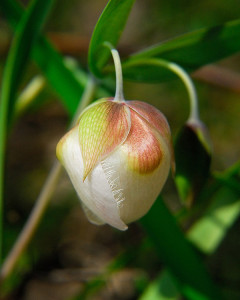
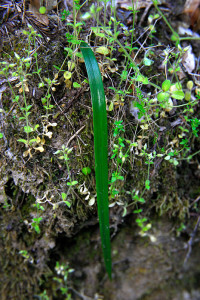
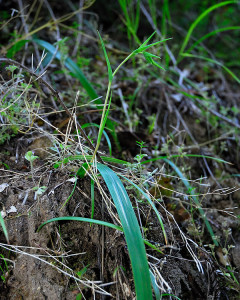

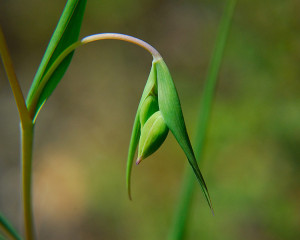
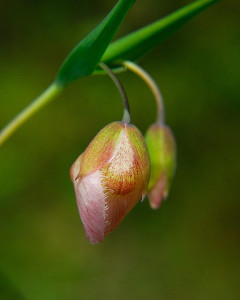
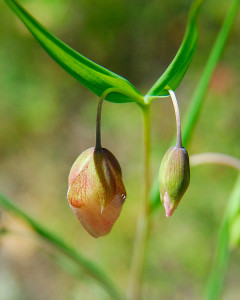
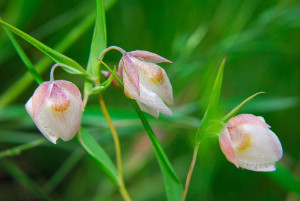
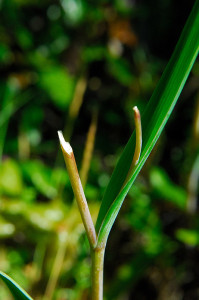

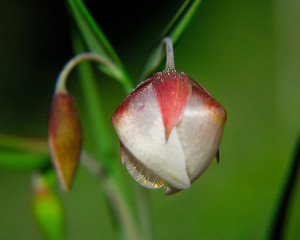
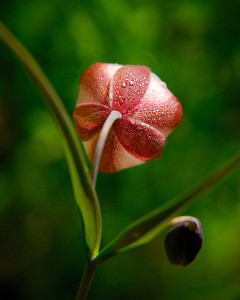
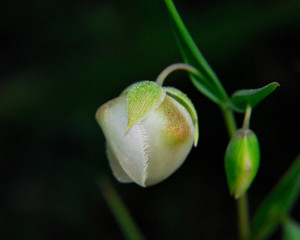
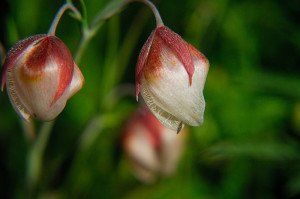







That reminds me of a misty mauve Gladiolus gracilis that came up in the last garden, in the beginning. But once I started gardening I lost it. Long slender grasslike leaves that are easily overlooked or smothered by the opposition.
That’s why we’ve been waiting to see what these plants are. Between the native Iris and Calochortus, we seem to have a few plants here that are somewhat grass-like, at least in parts of their development. It would be so easy to accidentally rip them out when pulling grassy weeds, unless you see them blooming and know where they are in the garden!
We get the Yellow Globe Lilies around here. They are stunning. I wish I could have them grow in my garden.
.-= Dog Island Farm´s last blog ..Yogurt and Yogurt Cheese =-.
Oh, the yellow ones? Really? Do you think they’re Calochortus pulchellus, the Mt. Diablo Fairy Lantern? If so, they’re listed on the CNPS list of rare, threatened or endangered plants. CNPLX does list a nursery in Berkeley that carries bulbs if you’d really like them in your garden!
I enjoyed your photos and the information about your nice little plant. The bloom kind of reminds me of hellebores.
.-= Corner Garden Sue´s last blog ..Mish Mashing =-.
I think I love the name, Fairy Lantern, best. The flowers are so delicate. It is cool how they start out as a single blade.
.-= Noelle / azplantlady´s last blog ..Pretty In Pink…..With A Hidden Secret =-.
I adore this plant, and unfortuately, it’s very hard to get bulbs — which probably means they are difficult to grow. So, for now, I’m enjoying the other Calochortus I have, and looking at the photos of yours.
How delightful for you and us to see this unique plant bloom… the deer too! Your photos are so stunning and tell the story so well. I love the poetry in your fifth photo. Lovely!
.-= Carol´s last blog ..Silent Sun Setting Sky Into Frost Then Heat Bursting Blooms =-.
What a beautiful flowers, and how nice that you finally got to see what they look like in bloom. You seem to have so many pretty natives growing there.
.-= Catherine´s last blog ..It may not feel like Spring, but it sure looks like it. =-.
It must be fun to go on rambles on your property and find such lovely little treasures. This is such a delicate looking little flower.
.-= Helen at summerhouse´s last blog ..A Study in Contrast or How I Created Two Very Different Mosaics from the Same Shards =-.
Beautiful photos. I love how you’ve captured them at every moment of their cycle (minus the dying back to the ground stage). I really like these little bulbs.
.-= Brad´s last blog ..Bringing Back the Natives Garden Tour 2010 =-.
Stunning! I’d never heard of them at all. They sound remarkably hardy too .. I wonder why they aren’t being grown elsewhere? The Californian climate is generally similar to the Australian one – I might have a look and see if anyone has imported them here … (here’s hoping!)
.-= Karly´s last blog ..Battle of the Blades – Fiskars vs. Felcos =-.
Based on ours here, growing in undisturbed soil, I might guess that they’re not particularly easy to propagate, or to grow in cultivation. I certainly wouldn’t call them prolific here by any stretch. However, for the patient and determined gardener, it would be one worth trying, if you can find them.
Quite often, if we look deeper and become more observant of nature, we find beauty in many things not seen before. These delicate flowers are pretty and nice to get to know them 🙂
.-= Autumn Belle´s last blog ..Calliandra surinamensis and The Powderpuff Girls =-.
Lovely. Thank you so much for the superb images and detailed account.
.-= graceonline´s last blog ..Earth Day pledge: One year War on Garbage =-.
What a sweet little flower! I think I need to try to grow these. Thank you for the link to the to the rare bulb nursery.
.-= Carla´s last blog ..New Addition to the Garden, Salpiglossis sinuata =-.
Thats a lovely little native you have on your property Clare. I’m so glad that finally your wait was worth it as they are beautiful looking little flowers especially when you click on the photos and enlarge them. I hope that those behind the deer fence will start to flourish on your orchard slopes. 🙂 Rosie
.-= Rosie@leavesnbloom´s last blog ..Tiptoeing Amongst the Scented Ballerinas =-.
It is “beautiful grass”, love it.
.-= Deborah at Kilbourne Grove´s last blog ..The Good, The Bad and The Dead =-.
You go on some pretty walks. I bet it is quite the site to see these growing naturally. Great photos, too!!
.-= Amy/GoAway, I’m Gardening!´s last blog ..The Art of Garden Pacing =-.
Beautiful! This year I noticed a bright blue flower atop some grassy foliage I have never noticed before. I don’t know its name or how invasive it might become, but it was lovely. I think this is a good year for native plants!
.-= debsgarden´s last blog ..A Crisis in the Lady Garden =-.
Beautiful grass, indeed! Love that scientific name, and the common name Fairy Lantern is even more wonderful!
Thank you for introducing us to this beautiful native plant, unfamiliar to me, and worth the wait for patient you 🙂 Appreciate the time it took to piece this together with thoughtful words and lovely photos. Let’s all keep our eyes open to the beauty around us!
.-= joey´s last blog ..‘SHOW ME YOUR GARDEN … ‘ ~ EARLY MAY COMPANIONS =-.
Oh! I adore Fairy Lanterns. I wonder if I’ve miss the ones on Mount Diablo.
I’ve seen them for sale at native plant sales, but held off buying until I better understood my garden.
.-= lisa´s last blog ..Native Bees =-.
Very lovely photos of the Calochortus albus. The flower form we have down here in SoCal (on the Santa Rosa Plateau in SW Riverside County) is pure white in color and known by the common name of “White Fairy Lantern.” A real gem to happen upon on a springtime hike.
Oh, Clare – I think this is one of the most beautiful flowers you have posted yet! I hope that you don’t loose to many of these lovely blooms to hungry critters!
.-= Heidi (GippyGardener)´s last blog ..Killer Snails and Lying Birds =-.
Thanks for visiting! Do you have any suggestions for me? Maybe some plant species or a design idea?
.-= Jenana´s last blog ..Hell hath no fury like a woman’s scorn =-.
Don’t you just love it when an unknown reveals it’s true identity when you finally catch it in bloom? I had my moment the other day when I caught a early meadow rue in bloom. There’s a place in the wet woods nearby where I kept seeing what I thought was a patch of stunted tall meadow rue that never bloomed.
.-= wiseace´s last blog ..Bugleweed Bumble Bee =-.
Oh my gosh, that fringe around the petal is too cute! I’m so glad they finally bloomed for you.
The insect damage reminds me of bumble bees who drill a hole through manzanita petals to get to the pollen inside. Could it be a pollination thing or a leaf-cutter bee lining her nest?
.-= Christine´s last blog ..An Afternoon in Ann’s Garden =-.
Well, looking at the holes carved in some of our Iris, and wild rose, I might blame some sort of leaf-cutter. It did save me having to vandalize a flower though to show the inside of the bloom!
The fringe on the petal reminds me of little teeth, at least in a couple of the photos…and I think they lend the flowers a vague resemblance to ‘Seymour’ from Little Shop of Horrors 😛
That is just stunning, from the delicate, graceful flower stalk to the variable sepals to the fine fringes on the petals. Lovely photos, Clare. This series of shots was just magical.
“Fairy Lantern” indeed!
.-= Meredith´s last blog ..wordless wednesday: wisteria =-.
That is completely enchanting, I’ve never seen one before! At first glance I thought it was an unopened native orchid until I started to read your description. I’m so glad they finally bloomed for you!
.-= Eliza´s last blog ..How to Grow Vegetables (Archive Directory) =-.
Such delicate beauties and your photos capture them perfectly.
.-= Jennifer´s last blog ..Reptiles in a Canadian Garden??? =-.
Lovely photos – I have a picture of one that I took several years ago, hanging on the wall. I love how they look, very still. I’m so excited because for the first time, I found one growing on our property. It’s below the redwood grove, and above the corral, where there is about a four foot bank – it is fairly shady there.
.-= Country Mouse´s last blog ..Sambucus Mexicana – I think! =-.